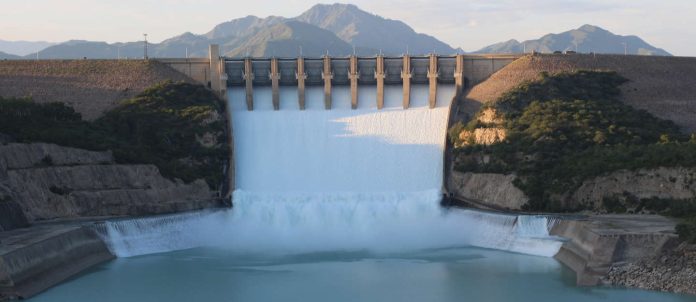
A Herculean Undertaking
The conception of the Tarbela Dam was rooted in necessity, emerging from the intricate hydrological challenges of the Indus Basin. The ambitious project was initiated in 1968 as part of the Indus Basin Project, an intricate response to the Indus Waters Treaty between India and Pakistan. The dam’s construction aimed to harness the waters of the Indus River, ensuring a reliable supply for irrigation and generating hydroelectric power to fuel the burgeoning needs of a rapidly developing nation.
The scale of the Tarbela Dam project is staggering. Stretching over 9,000 feet in length with a height of 485 feet, the dam’s sheer size is enough to boggle the mind. Its reservoir, known as Lake Tarbela, covers an area of approximately 250 square kilometers and has a storage capacity of 13.69 cubic kilometers. The construction required the movement of about 153 million cubic meters of earth and rock, making it a true leviathan of earth-filled engineering.
The Engineering Marvel
What sets the Tarbela Dam apart is not just its size but the sophisticated engineering that underpins its design. Unlike traditional concrete dams, an earth-filled dam relies on compacted earth and rock to hold back the immense pressure of the water. This approach requires meticulous planning and execution, ensuring that the materials are compacted to optimal density to prevent seepage and structural failure.
At Tarbela, the dam’s core is made of impermeable clay, flanked by zones of sand, gravel, and rock, each layer meticulously engineered to counteract the immense hydraulic forces. The dam’s spillway and tunnels, capable of discharging up to 42,000 cubic meters of water per second, are feats of hydraulic engineering designed to manage the Indus River’s seasonal flows and mitigate the risk of flooding.
Multifaceted Impact
The impact of the Tarbela Dam on Pakistan’s socio-economic landscape cannot be overstated. Primarily designed for irrigation, it plays a pivotal role in sustaining the agriculture sector, which is the backbone of Pakistan’s economy. The dam’s extensive canal system irrigates millions of hectares of farmland, significantly enhancing crop yields and ensuring food security for the country.
In addition to irrigation, the Tarbela Dam is a powerhouse of hydroelectric energy. With a current installed capacity of 4,888 megawatts, it is one of the largest sources of renewable energy in Pakistan. The electricity generated by the dam is crucial for meeting the energy demands of an ever-growing population and supporting industrial growth.
Furthermore, the dam has been instrumental in flood control. By regulating the flow of the Indus River, it has mitigated the devastating impacts of seasonal floods that previously wreaked havoc on downstream communities.
Environmental and Social Considerations
While the Tarbela Dam’s benefits are immense, its construction and operation have not been without controversy. The creation of the reservoir led to the displacement of thousands of people, raising significant social and ethical concerns. Efforts were made to resettle the affected communities, but the process was fraught with challenges, reflecting the complex interplay between development and human rights.
Environmental concerns also loom large. The inundation of vast areas altered local ecosystems, impacting flora and fauna and transforming the natural landscape. Moreover, the sedimentation in the reservoir poses a long-term challenge, potentially reducing the dam’s storage capacity and affecting its operational efficiency.
A Vision for the Future
As Pakistan continues to grapple with water scarcity and energy demands, the Tarbela Dam remains a cornerstone of its infrastructure strategy. Recent upgrades and expansions, such as the Tarbela 4th Extension Hydropower Project, are aimed at enhancing the dam’s capacity and extending its operational life. These initiatives reflect a broader vision to optimize the utilization of existing resources while exploring sustainable and innovative solutions to meet future challenges.
The Tarbela Dam stands as a monumental achievement in the annals of engineering history. Its construction and ongoing operation embody the complex interplay of technological prowess, socio-economic imperatives, and environmental stewardship. As the largest earth-filled dam in the world, Tarbela is not just a marvel of human ingenuity but also a symbol of Pakistan’s enduring quest to harness the bounties of nature for the greater good.











